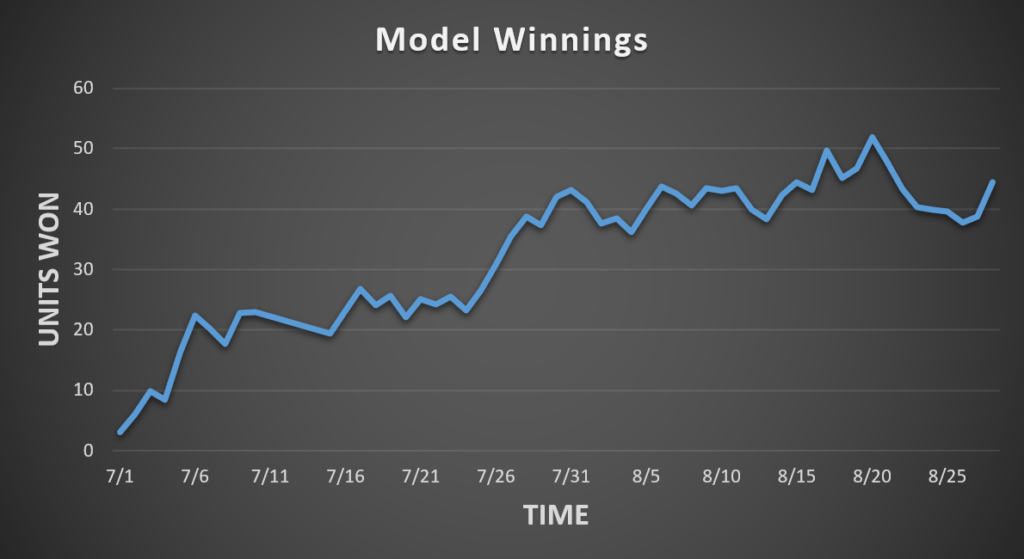If you have followed me for the past week or so with my MLB betting model, you may know I was driving my bankroll into a bottomless ditch. After a huge 4.7 unit winning day on August 20, I was hit with SIX painful losing days in a row: 8/21: -3.7 units, 8/22: -5.0 units, 8/23: -2.8 units, 8/24: -0.4 units, 8/25: -0.3 units, 8/26: -1.8 units
It was my worst losing streak that I can remember. I lost 13.85 units in just under a week, which was about 27% of this season’s winnings. It was so painful that I didn’t even want to check the scores. The worst part was that I didn’t change my strategy at all. I didn’t get cocky over-betting or going for crazy parlays. I was sticking to the same system that had made me 52 units at a 11.85% ROI prior to this streak. The day before it started, August 20, I was at a season high for winnings. This streak set me back to where I was two weeks ago, so I did a deep dive into my model to try to pinpoint a common theme.

Over these six days, I made 43 bets in the 82 games that were played, or 53.8%. This was a bit lower than my season average of 63.7% of games, but I simply account that to sportsbooks pricing teams closer to my predictions. In this span, I went 15-28 overall.
First, I checked how I was doing picking favorites and underdogs. If you did not see my July report, underdogs had accounted for 94% of my winnings that month – just shy of 41 units (see below). With this in mind, I thought I might be betting too many favorites. Since I have to bet more on favorites to win a betting unit, those losses can add up quickly; even if you are close to winning half those bets. This was part of the reason for my cold streak, but it was just scratching the surface.

My model went 11-11 over this stretch picking favorites. As I just mentioned, winning half your bets on favorites won’t win you money – and I lost 3.18 units in these bets. Simple algebra will tell you that the remaining 10.67 units lost had to come from betting on underdogs. The record picking underdogs is just as depressing, having gone 4-17. This was stunning. Underdogs had been my bread and butter, and I was even debating strictly betting on underdogs with my model just a week ago. If I had, I still would have saved the 3.18 units lost to favorites, but this still made me very uneasy.
This finding still didn’t quite explain what exactly was going on, though. My model was either wildly off predicting an underdog’s chance of winning, or it’s just been a painful variance in the expected outcomes. I needed to find out quickly to stop the bleeding.
Next, I looked to see if my picks were heavy on betting road or home teams. The picks leaned a bit towards road teams, but the unit loss didn’t differ as much: 4-10 for home teams (-6.3 units), 11-18 on road teams (-7.5 units). Although I did have 67.4% of bets on road teams, this did not vary at all from my model as a whole. Since July 1, I have bet on the road team 65.7% of the time; and a 1.7% difference for a sample size of six games is essentially irrelevant. I can cross out home vs. road as a factor on its own.
What I did next steered me in the right direction: I combined the two above tests by looking at favorites and underdogs performance at home and on the road. This was pretty eye opening:

Home favorites and underdogs both went 2-5, splitting the 4-10 overall home record. Betting the road team did not perform as evenly – road favorites actually did well at 9-6 winning 0.61 units, while road underdogs did horrible going 2-12 and losing 9.48 units.
As I mentioned earlier, underdogs had accounted for almost all my winnings and had been about two-thirds of my picks overall. Essentially, my edge disappeared. Underdogs still won games; I was simply picking the wrong ones. So, I then looked at who these losing underdogs had played. Of the twelve road underdog losses, nine of them played playoff-contending (over .500) teams. So, nine of twelve losses betting road underdogs were picks against the top teams in baseball at home.
That is certainly something to consider and a trend I can see continuing. The lull of the season is over and teams in contention for a playoff berth are locked in. Additionally, lower ranked teams typically call up and give playing time to their up and coming prospects, especially in September when rosters expand to 40 players. Playoff-bound teams will do the opposite, and scrap for every win to earn their spot in October.
In summary, teams at the bottom of the standings on the road may be good to fade for the rest of the season. Not that tanking is an issue in MLB, as FanGraphs pointed out last offseason, but teams at the top will simply be more focused. Contenders will work as a team rather than worry about individual performance. I’ll definitely still be betting underdogs through the rest of the season, but I will be much more selective.
If you enjoyed reading about how I lost a bunch of money and want to learn more from my successes and failures, than subscribe to my blog here! I try to write a new article each week about sports betting strategies and tips for you to be more successful. You'll also receive my free MLB picks daily, which as you saw have done quite well aside from the week described above.
As always, feel free to shoot me a message any time.
Best of luck,
Stephen